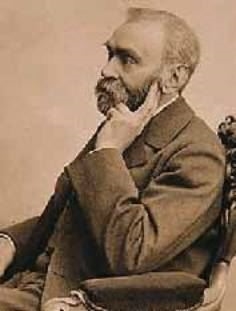 |
| Nobel (From a web page) |
Alfred Bernhard Nobel was born on 21 October 1833 in Stockholm, the capital city of Sweden. His father named was Emmanuel, his mother Andriette, and his two elder brothers were Robert and Ludwig. He also had a younger brother who was 10 years younger than him named Emil.
When he was a child, Nobel had shown great talent and interest in literature and experiments, which later helped him to make the decision to be a scientist. Nobel loved to visit his father’s factory which produced explosive material such as the ‘water bomb.’ Nobel actually loved peace, he always dreamed about a peaceful world and no war, but at that time, his dream was only a dream. Nobel helped his father in finding explosive materials for mining. His first invention was based on Nitroglycerin.
Even though these explosive materials were famous at that time, Nobel soon found that his invention was too dangerous. It was the fault of nitroglycerin’s form, which was liquid. A lot of people became the victims of this invention; one of them was his own brother, Emil. Soon, most of the factories were prohibited to continue their activity since the country saw it was too dangerous.
This condition forced Nobel to find another kind of explosive material. He worked day and night, trying to change the liquid form of nitroglycerin into solid state. He tried to mix it with gunpowder, charcoal powder, and many more, but nothing worked. Finally, when he was out for a walk he found Kieselguhr earth. He decided to try it for the nitroglycerin’s mixture and was satisfied with the result. He named this new explosive material ‘Nobel’s Save Explosive’ which was called ‘dynamite’ later. Together with his father, they received an award from the Sweden’s Scientist Association. Not long after that, his father died.
After the invention on dynamite, Nobel realized that dynamite had less destructive power than what nitroglycerin could do. It was because the Kieselguhr not only didn’t explode, but also absorbed most of the calories, leaving nitroglycerin less destructive. He tried to mix nitroglycerin with collodion (nitrocellulose and acetone) and found a safer and stronger explosive materials. He named it ‘gelatin’. It happened in 1857, when he reached the age of 42.
At 1876, Nobel put out a pamphlet looking for a secretary. He met a young Russian woman named Bertha, who shared his caring for peace. He never used any other secretary after Bertha went home to get married.
Alfred Bernhard Nobel never stopped experimenting on explosive material. Later he found ‘Balastite’, a non-smoke explosive.
1888 was a disastrous year for Nobel. He had to deal with spies and the news of Ludwig’s death, which left him grief stricken. One year later, his beloved mother joined his father, Ludwig, and Emil.
1889, Nobel sold his patent on Balastite to the Italian government, an action that made the French government where he lived angry; almost all of his belongings were sealed by the army. This condition made him leave France and headed to San Remo, Italy. There, he made a laboratory with complete facilities; this laboratory was called San Remo Laboratory later.
As he gained age, Nobel’s interest diverted from weapons to peaceful products. His experiments were wide ranging, from synthetic skin, imitation jewelry, and even synthetic silk.
August 1892, a group of peace lovers hold a peace meeting in Switzerland. The main speaker was Madame Bertha von Suttner, Nobel’s secretary 10 years ago. Nobel had a talk with Bertha, and decided that he couldn’t really follow their activity due to his old age and lots of experiments. But he supported them.
1893, Nobel who only attended school for one year, got a degree on Philosophy. Later on, he was called Professor Nobel.
After his 60th birthday, Nobel often got heart attacks. His health worsened with rheumatic. At this time, Nobel started to think about making a will and testament. He didn’t want to give his inheritance to his family. He thought that it would only made them greedy and lazy. At last he made a will that would leave his fortune to people who worked for others. There were five categories for this prize: physics, chemistry, literature, peace, and pharmacy. This testament was kept in a Swiss Bank and was known as the Nobel Prize.
August 1869, Robert died in Sweden at the age of 68 years old. This shock sent Nobel nto a catastrophic state. He had to stay in bed and was ill for 3 months before died at December 10th 1896 in Italy.
Page created on 4/4/2006 12:00:00 AM
Last edited 4/4/2006 12:00:00 AM
